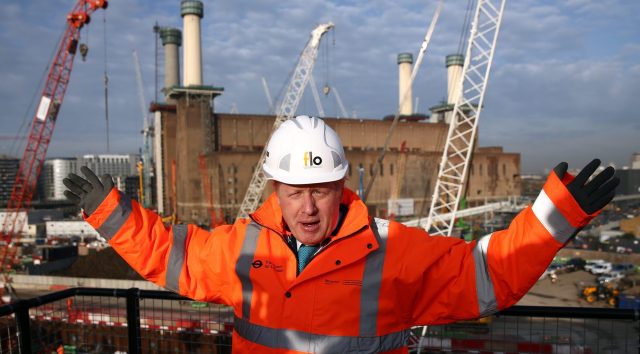Boris the builder. Credit: Carl Court/Getty Images

Whenever an ‘old Indian burial ground’ is mentioned in an American horror movie, you can be sure that building upon it will prove a very bad idea. Mayhem and terror is bound to be unleashed.
In British politics, the green belt is regarded with equal trepidation. Only last week, Tory leadership rivals, Boris Johnson and Jeremy Hunt, agreed that building more homes should not mean building on the restricted development zones that surround London and other UK cities.
Those hoping that a change of Prime Minister might bring change were disappointed. For instance, James Forsyth of The Spectator made his feelings known:
“Boris Johnson and Jeremy Hunt on the green belt is so depressing. If Britain ceases to be a property owning democracy, the centre right will not win elections.”
Frustration is mounting. After 13 years in which New Labour created the housing crisis, the Tories have spent the last nine years not solving it. In all that time, the green belt has remained sacrosanct – despite rising house prices and falling levels of home ownership.
However, on the pro-development side, I fear that the green belt has become an inverted taboo, something that must be violated in order to prove one’s commitment to the worthy cause of homes for all. Indeed, the most fanatical of the anti-nimbys positively embrace the concept of sprawl.
Yet according to Ellie Anzilotti for Fast Company, public demand is shifting away from the suburbs. Instead of assuming an unchanging American dream, researchers from George Washington University and Smart Growth America took a look at where Americans are choosing to live now:
“…sprawling communities of single-family homes that require a car to navigate are not what’s drawing people anymore. What’s popular now are places where people can live in mixed-use, multifamily housing—maybe an apartment building above a coffee shop—and walk, bike, or take transit to get around.”
Their report, Foot Traffic Ahead: Ranking Walkable Urbanism in America’s Largest Metros, identifies 761 densely built, but liveable, communities in urban centres across America. Collectively, they only cover less than 1% of America’s 30 biggest metro areas, but in terms of new development they are all important:
“While sprawling, suburban districts have added no new development and in some cases, lost occupancy since 2010, nearly all new office and multifamily housing construction has clustered in these 761 areas.”
Similar trends are visible in Britain too – with the fashion for city centre living no longer limited to London. But it isn’t just a fad. The knowledge economy puts a premium on connection and therefore proximity. The plum jobs are bunched up together in the superstar cities. Moreover, there’s a growing reaction, especially among the young, against car-centric lifestyles – not only on environmental grounds, but also because of the cost and hassle of ownership.
By definition, space in city centres is constrained; and, as demonstrated by the Mayor of London’s rejection of planning permission for the Tulip tower, there are limits to vertical development. So does that mean we’ll have to default to sprawl whether we like it or not? Will the bright young things have no choice but to become the Margo and Jerry Leadbetters of the 21st century?
I don’t think so, because though city-loving hipsters tend to grow up, start families and even buy houses and cars, they’re not going to conform exactly to the lifestyles of their parents and grandparents. They will want to maintain access to the economic and cultural opportunities to which they’ve become accustomed – as well as new priorities like good schools.
Fortunately, there is a third model for providing more homes. As Anzilotti writes “density and walkability do not have to be limited to the urban core”. The future is one of ‘polycentric development’ – i.e. not just one focal point right in the middle of the metropolis, but other hubs further out – “connected to both the urban core and each other by sustainable transit.”
What does this mean for planning policy? For a start it doesn’t mean replacing the green belt with carte blanche for piecemeal, build-what-you-will development. That would just add up to sprawl.
Achieving polycentric development will require direction – and, indeed, intervention – on the part of government to ensure density, good design and the provision of supporting infrastructure.
It also means biting whole chunks out of the green belt – but only where it prevents necessary development in strategic locations. If we’re truly serious about providing enough new homes without sprawl then we need to do things like build sustainable urban extensions to cities like Oxford or garden villages around rural railway stations – just the sort of smart development that our taboo-laden planning system currently makes impossible.
We urgently need an honest, open debate about how, where and when to make this happen.
With the normal business of government paused and the attention of the nation’s press undivided, the Conservative leadership contest might have been an opportunity to have that debate. In the process the candidates might have sent a message of hope to the younger voters without which the Party is finished.
But Messrs Johnson and Hunt obviously didn’t want to go for that.










Join the discussion
Join like minded readers that support our journalism by becoming a paid subscriber
To join the discussion in the comments, become a paid subscriber.
Join like minded readers that support our journalism, read unlimited articles and enjoy other subscriber-only benefits.
Subscribe